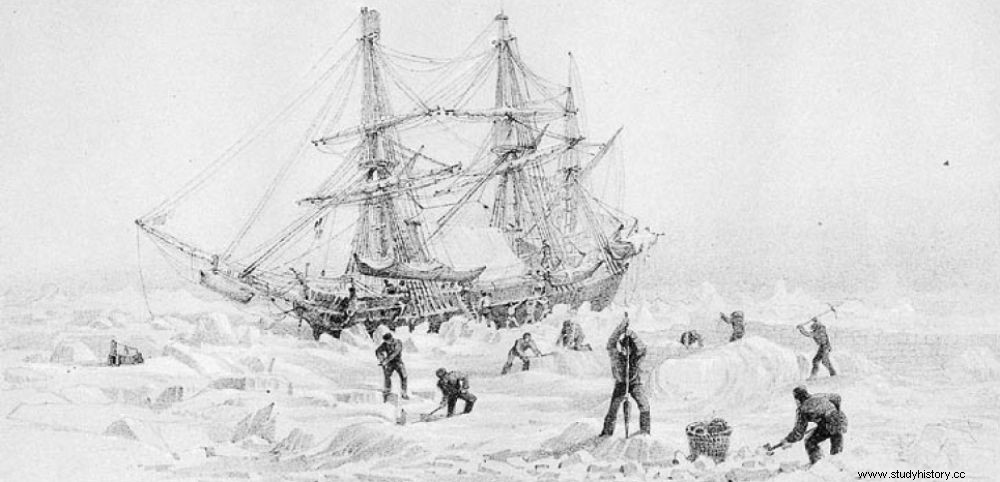 Engraving depicting the "HMS Terror" caught in the ice. The Franklin Expedition, named after its commander Sir John Franklin, set out in search of the Northwest Passage in 1845.
Engraving depicting the "HMS Terror" caught in the ice. The Franklin Expedition, named after its commander Sir John Franklin, set out in search of the Northwest Passage in 1845. DISCOVERY. Extraordinary! Barely two years after discovering the HMS Erebus, lost ship of the disastrous expedition of the British John Franklin, 168 years ago, the HMS Terror , the second building searched for, has just been found by Parks Canada teams in… Terror Bay, in the territory of Nunavut, Canada. That is 96 km south of where the boat was supposed to have been crushed by the ice. It would have been caught in the ice floe somewhere between King William Island and Victoria Island.
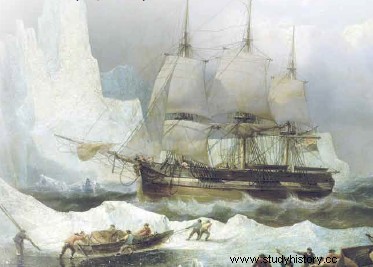 According to the British newspaper The Guardian to whom we owe this exclusive information, the wreck of the HMS Terror lies in perfect condition at the bottom of the icy arctic waters. The two ships that set out from Britain in May 1845 in search of the famous "Northwest Passage", a new sea route linking the Atlantic Ocean directly to the Pacific, had to be abandoned by their crews in 1848, after three years of navigation. This led to the disappearance of all 129 men on board, all of whom died in atrocious conditions of hunger and cold.
According to the British newspaper The Guardian to whom we owe this exclusive information, the wreck of the HMS Terror lies in perfect condition at the bottom of the icy arctic waters. The two ships that set out from Britain in May 1845 in search of the famous "Northwest Passage", a new sea route linking the Atlantic Ocean directly to the Pacific, had to be abandoned by their crews in 1848, after three years of navigation. This led to the disappearance of all 129 men on board, all of whom died in atrocious conditions of hunger and cold.
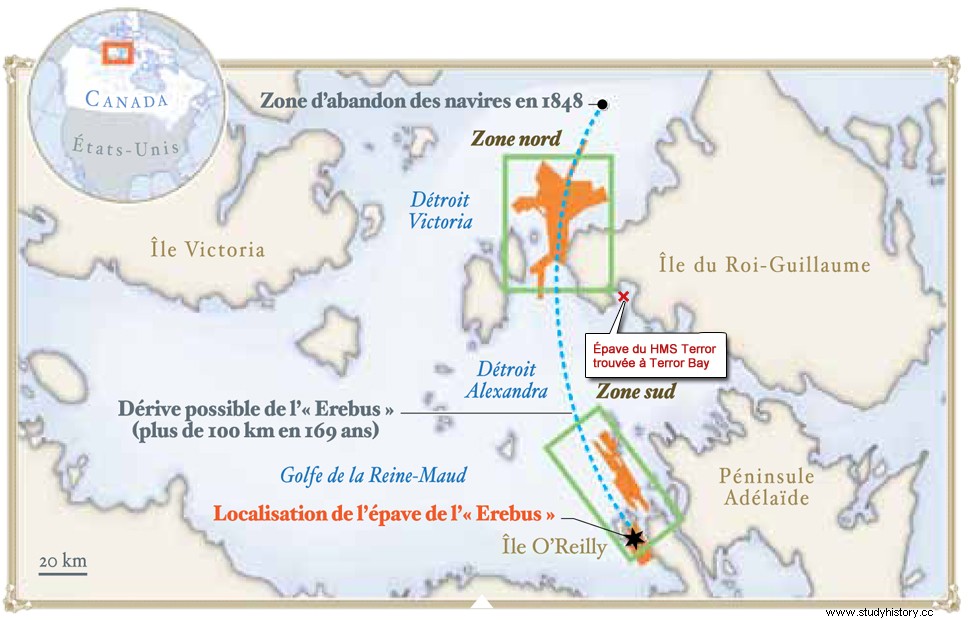
Location of the two wreck sites of HMS Terror (2016) and HMS Erebus (2014) found by Parks Canada archaeologists. In orange, the two main areas explored since 2008. © According to Parks Canada
"September 3, 2016, the 10 crew members on board the ship "Martin-Bergmann" discovered the "HMS Terror" with its three broken masts. He was standing with almost all the hatches closed in the middle of the unexplored area of Terror Bay in King William Island (English:King William Island),” says Canadian journalist Paul Watson, author of the Guardian article. . As the research vessel was preparing to leave the premises to continue its exploration, a strange figure appeared on the screen of the sounder (high definition acoustic system which continuously provides an image of the seabed). It was the HMS Terror , commanded at the time by Captain Francis Crozier, which lay delicately on the seabed.
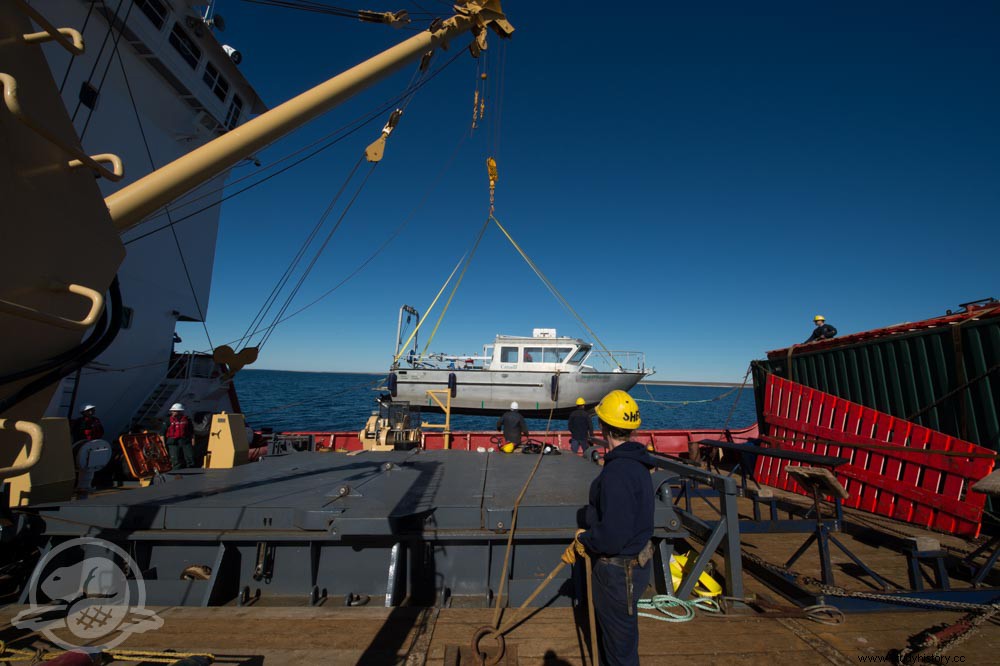 2016 Parks Canada Exploration Campaign:Launching the CCGS Investigator from the Sir Wilfrid Laurier. ©Parks Canada
2016 Parks Canada Exploration Campaign:Launching the CCGS Investigator from the Sir Wilfrid Laurier. ©Parks Canada
On Sunday, September 10, 2016, thanks to a small remote-controlled robot, the researchers managed to enter the interior of the ship, as explained in detail by Adrian Schimnowski, the director of operations, from the research vessel still at sea. of each expedition since they were launched in 2008 by former Canadian Prime Minister Stephen Harper, archaeologists from Parks Canada have shared the maritime territory to be explored. "Three ships were at sea at the time of discovery “, explained to Sciences et Avenir the French underwater archaeologist Elizabeth Veyrat (DRASSM), in contact with the crews on board Parks Canada. "The Canadian Coast Guard icebreaker 'Sir Wilfrid Laurier', where the majority of the search party is, and the Royal Canadian Navy 'HMCS Shawinigan' were all sailing at the northern end of the Victoria Strait, when the "Martin Bergmann" chartered by Artic Research discovered the "Terror" », specifies the researcher.
Big stories always hiding smaller ones, the Guardian reported that the wreck of HMS Terror was located after the Martin-Bergmann diverted its course following the story of an Inuit member of the crew. He explained that while going fishing 6 years earlier, he had noticed a large piece of wood sticking out of the ice on the side of Terror Bay... We bet that when they return to dry land, a large party should bring together all the participants in this exceptional operation. Not to mention the revelations that the next excavations of this perfectly preserved ship will be able to deliver.
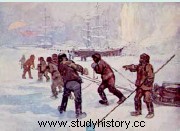 Prisoners of the ice, sailors from HMS Erebus and HMS Terror on the pack ice. © The Stappleton Coll./Bridgemanimages
Prisoners of the ice, sailors from HMS Erebus and HMS Terror on the pack ice. © The Stappleton Coll./Bridgemanimages
Two ships so well prepared...
With their hulls reinforced with wooden beams and iron plates, a 20 horsepower steam engine to reinforce the traditional sails, the HMS Erebus and HMS Terror were designed to maneuver in pack ice. In the holds, they also carried 3 years worth of provisions:60 tons of flour, 14 tons of beef, 15 tons of canned meat, lemon to avoid scurvy... When they left Great Britain, no one doubted the success of the operation. But after their departure, several months passed without any news. In 1848, research expeditions were finally launched. In total, more than 52 ships followed one another to try to find the Erebus and Terror , leading in turn to other dramas. In vain. It wasn't until 1859 that a ship chartered by John Franklin's widow discovered two messages tucked away in cairns (small heaps of stones) on Beechey Island and King William Island. We learn that the two boats were caught in a vice of ice in the Victoria Strait where they would have been stuck for a year and a half. Captain Franklin and 23 members of the expedition are said to have died on June 11, 1847 without the causes being specified. Finally, on April 22, 1848, Captain Crozier is said to have ordered 105 survivors to leave the ships in an attempt to walk back to dry land. It wasn't until the discovery of the first bodies, preserved in the ice, that the extent of the suffering endured by these men came to light... None of these men will return alive.
Also read our article in Sciences et Avenir n°815 January 2014
